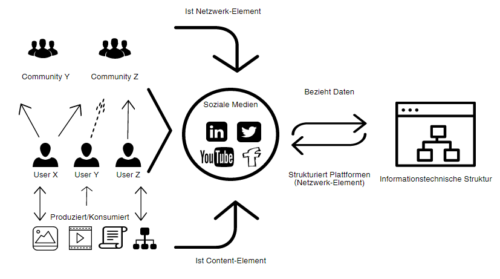In meinem Forschungsvorhaben mit dem Arbeitstitel „Kulturen im Netz – Netz der Kulturen: Mexikanische Social Media Communities in den virtuell-medialen Räumen der Produktion und Vernetzung“ untersuche ich die Relationen zwischen den sozialen Plattformen, ihren Nutzern und Communities und der Produktion und Vernetzung anhand von Vertretern der mexikanischen Social Media Communities.
Zunächst ist zu klären, wie in dieser Arbeit soziale Medien definiert sind und wie sich diese strukturieren. Die Kernelemente der sozialen Medien bilden das Netzwerk-Element und das Content-Element, welche auf einigen Plattformen bspw. auf YouTube in der Kanalseite der einzelnen Benutzer konvergieren (angesehene/gelikte Videos als Content- sowie Netzwerkelement). Das Charakteristische der sozialen Medien besteht somit aus ihrer Dualität der Netzwerk-Elemente und Content-Elemente, wobei die Netzwerk-Elemente durch eine Verknüpfung des Nutzers, als auch durch automatische Strukturen und Ontologien der informationstechnischen Strukturen produziert werden. In der Konsequenz möchte ich soziale Medien im Allgemeinen als Portale/Plattformen zur Präsentation, Produktion und Distribution von digitalen Objekten (nach Yuk Hui 2012; 2016) beschreiben, welche unter dem folgenden Schema operieren:

Ziel ist es durch diese Betrachtung festzustellen, inwieweit man von einer Netzkultur sprechen kann und wie das Verhältnis der unterschiedlichen kulturellen Räume in den sozialen Medien verhandelt wird. Welche kulturellen Identitäten und Gruppen lassen sich finden, wodurch kennzeichnen sich diese und inwieweit unterscheiden sie sich von ihrem „Offline“-Äquivalent?
[...]
Quelle: http://dhdhi.hypotheses.org/2966
